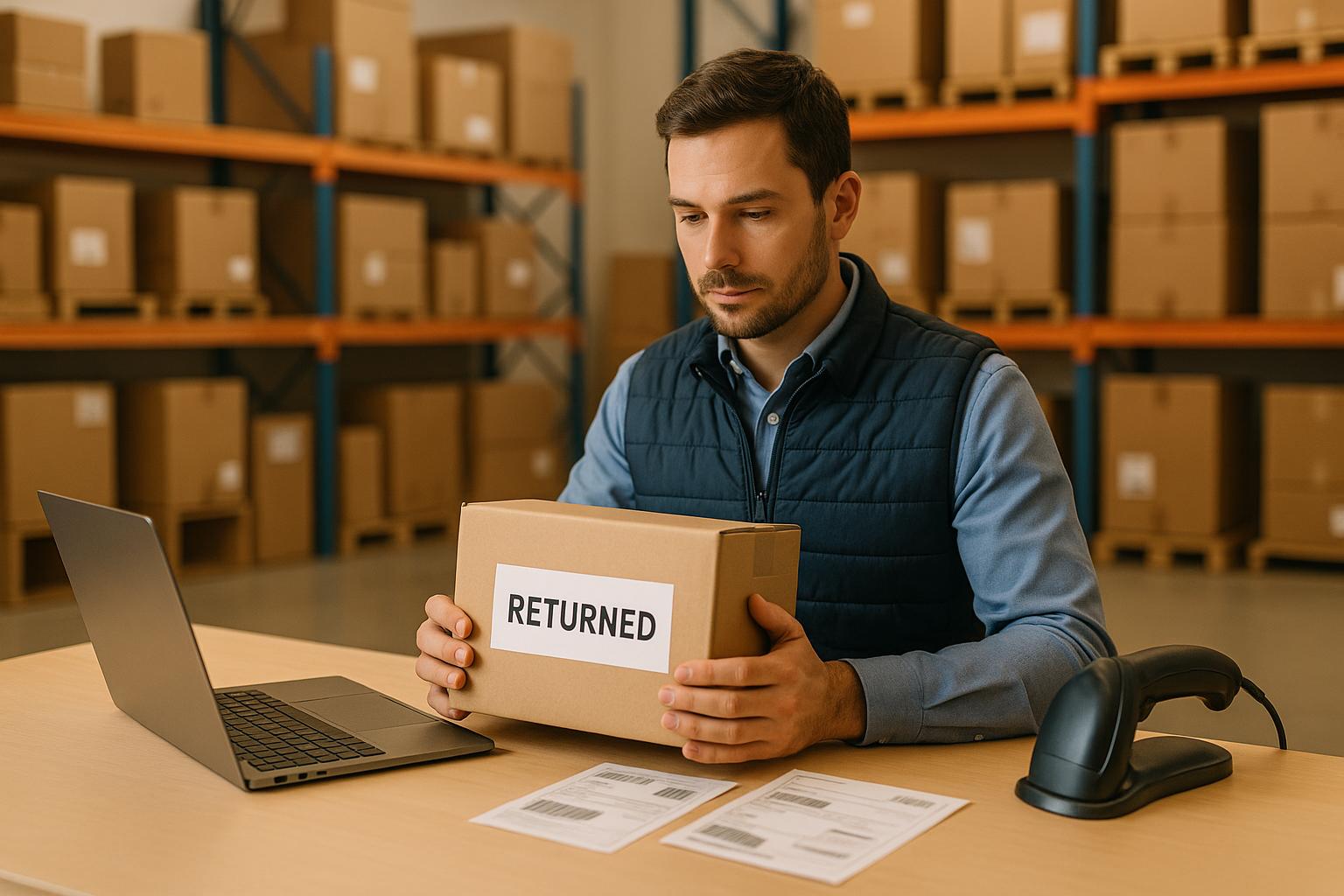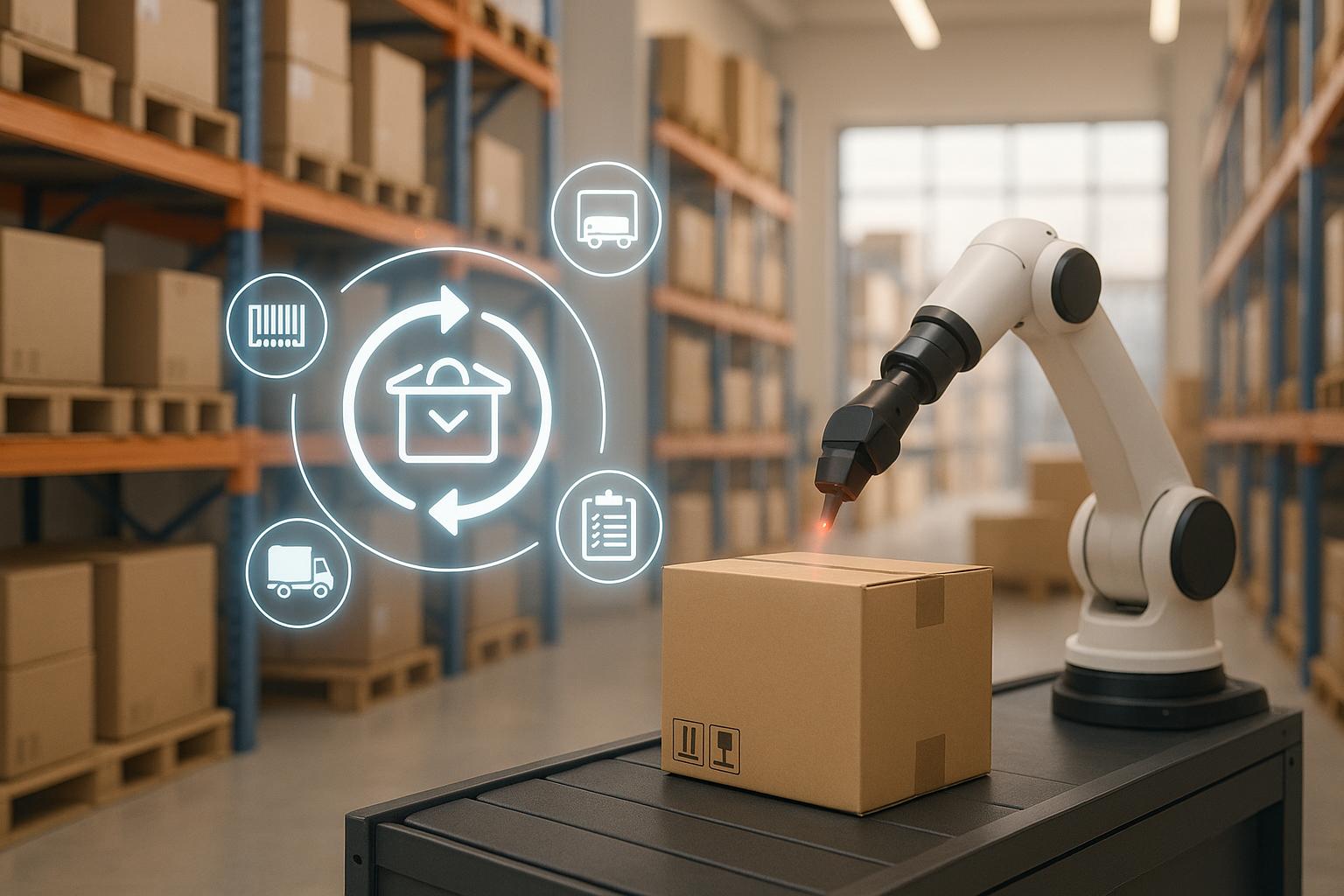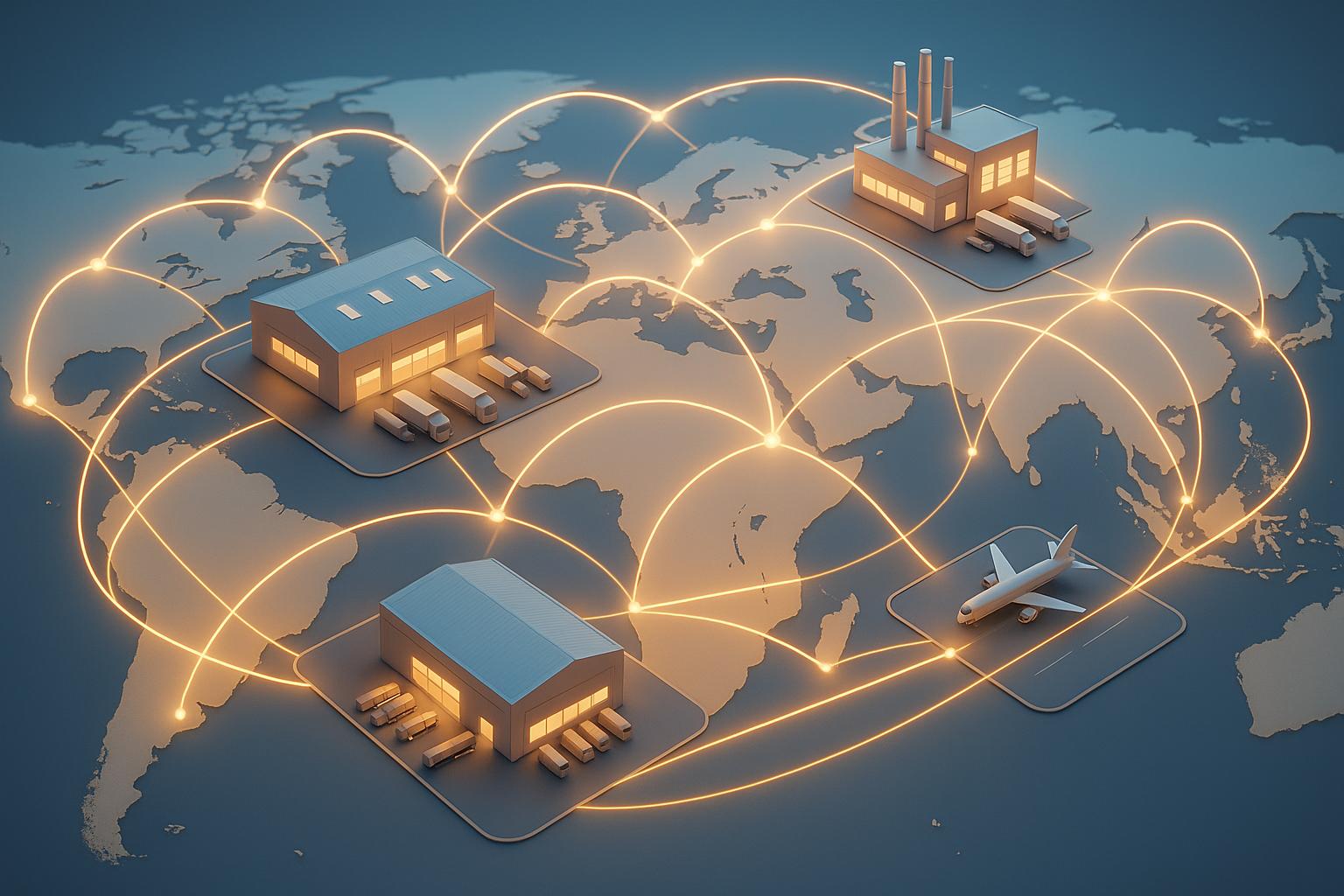3PL Returns Handling: Step-by-Step Guide

Handling e-commerce returns efficiently is critical for businesses, especially with return rates as high as 30% in certain categories. Outsourcing this process to third-party logistics (3PL) providers can cut costs by up to 25% and improve customer satisfaction, as 92% of shoppers are more likely to buy again if returns are simple. Here's how 3PLs manage returns:
-
Step 1: Initiating Returns
Customers start returns via portals or in-store programs, receiving RMAs (Return Merchandise Authorizations) for tracking. Clear return policies ensure smooth processing. -
Step 2: Shipping and Receiving
Prepaid labels, drop-off points, and home pickups make returns convenient. Upon arrival, items are scanned, verified, and logged into inventory systems. -
Step 3: Inspection and Sorting
Items are checked for condition, completeness, and functionality. They are sorted into categories: restockable, repairable, or disposable. -
Step 4: Restocking, Repairing, or Disposing
Restockable items are repackaged and added to inventory. Repairable products are refurbished, and unsalvageable items are responsibly recycled or disposed of.
Technology and communication enhance the process: Barcode scanning, real-time tracking, and automated updates reduce errors and improve transparency. Quick refunds and clear communication build trust, encouraging repeat business.
How a 3PL Handles Return Orders
Step 1: Starting and Approving Returns
The return process kicks off when customers decide to send an item back. Third-party logistics providers (3PLs) make this process smoother by collecting key data and ensuring proper tracking.
How Customers Start Returns
Customers typically start returns through online portals or in-store programs. The most common approach involves entering order details, selecting the items to return, and receiving a QR code or printable shipping label.
Some advanced 3PLs go a step further by offering perks like home pickup services or Buy Online, Return In Store (BORIS) options. Many even cover return shipping costs to remove financial hurdles. The goal is simplicity - returns should be hassle-free while still capturing all necessary tracking details.
Once the customer initiates the return, the process moves forward with the assignment of a Return Merchandise Authorization (RMA) number.
Return Merchandise Authorization (RMA)
After a return is initiated, the system generates an RMA number - a unique code that follows the item through every stage of the return process. This number appears on all shipping documents and connects the returned item to the customer’s original order within the 3PL's system.
RMA numbers are essential for more than just tracking. They enable businesses to analyze return data, identify common reasons for returns, and detect patterns that could point to quality issues or customer dissatisfaction. For customers, the RMA number provides transparency, allowing them to check the status of their return or communicate with customer service more effectively.
With the RMA in place, the next step involves setting clear rules for how returns are handled.
Return Requirements and Rules
A solid return policy needs to outline specific conditions for returned items, such as requiring products to be unused, in their original packaging, and with tags still attached. Time limits are also crucial - many U.S. retailers stick to a 30-day return window. Policies should also clarify the difference between defects covered under warranty and problems caused by customer misuse or normal wear.
The process for inspecting returned items and issuing refunds should be clearly explained. Customers need to know how their items will be evaluated, what qualifies for a full or partial refund, and how long the process will take. Clear guidelines help everyone understand which items can be restocked, which need repairs, and which should be discarded.
Step 2: Managing Return Shipping and Receiving
After customers receive their RMA numbers and understand the return process, the next step is ensuring items are efficiently shipped back to the warehouse. This involves coordinating shipping logistics and handling the arrival of returns at the 3PL facility.
Return Shipping Methods
Making return shipping easy and accessible is key to minimizing obstacles for customers. Many 3PL providers offer prepaid return labels, which customers can print at home or access via QR codes on their phones. These labels simplify the process by clearly outlining shipping costs and ensuring items are directed to the correct location.
Another option is drop-off locations, which add flexibility for customers. Leading 3PL providers often partner with retail chains, shipping centers, and postal facilities to create extensive networks of drop-off points. These networks are particularly helpful in urban areas where customers can easily find a nearby location.
For oversized or heavy items, standard shipping isn’t always practical. In these cases, pickup services can be arranged directly from the customer’s address. This eliminates the hassle of transporting bulky items and reduces the chance of customers abandoning their returns.
Strong carrier networks and strategically located warehouses also play a major role in streamlining return shipping. Curtis Martin, Senior Operations Manager at Synnex, highlights the importance of working with logistics providers:
"JIT sets the bar high in logistics with on-time performance, flexibility for last-minute orders, competitive pricing, and professional service."
- Curtis Martin, Senior Operations Manager, Synnex
Some 3PL providers even go the extra mile by covering return shipping costs. Once the items are shipped, they move into the next phase: receiving and processing.
Receiving and Recording Returns
When returned items arrive at the 3PL warehouse, the receiving process must be precise and efficient. The first step involves verifying the RMA number against the shipping documentation to confirm the return aligns with the original request.
Using barcode technology, warehouse staff scan each item, instantly updating the warehouse management system (WMS). This real-time tracking notifies both the customer and the seller, ensuring transparency and reducing the risk of misplaced items.
The receiving process also includes detailed documentation. Key data points, such as the item’s condition, customer-provided notes about the return, and photographic evidence (when necessary), are recorded. This information not only helps resolve individual returns but also identifies patterns in return reasons, enabling sellers to address potential issues with product quality or descriptions.
A great example of an efficient receiving process comes from Red Stag Fulfillment. In 2023, they implemented QR codes and upgraded their documentation systems, resulting in a 25% reduction in return processing time and a 15% increase in customer satisfaction scores.
Advanced 3PL providers take it a step further with integrated systems that automatically update inventory as returns are processed. For instance, when an item is scanned and logged, the system can immediately determine whether it should be restocked, repaired, or discarded based on pre-set guidelines.
To maintain consistency and accuracy, regular staff training is essential. This includes instruction on inspection techniques, documentation standards, and system navigation. Routine audits and technology enhancements, such as automated routing based on return reasons and real-time reporting dashboards, enable 3PL providers to handle higher return volumes without sacrificing speed or precision.
Step 3: Checking, Sorting, and Quality Control
After items are received at the 3PL warehouse, the next step is inspection. This stage plays a crucial role in determining whether returned products can be resold, need minor repairs, or must be discarded entirely. It’s all about maintaining inventory accuracy and keeping customers happy.
Item Inspection Process
The first step in the inspection process is a thorough condition check. Warehouse staff carefully examine each item for physical damage, signs of wear, or any differences from the stated reason for return. This includes checking for missing parts and testing functionality to decide if the item is fit for resale.
Next up is completeness verification. Inspectors ensure that all components, accessories, and original packaging are included. For instance, returned smartphones must come with their chargers, cables, and packaging to qualify for restocking.
Inspectors also confirm that the item’s condition aligns with the return reason provided by the customer. Different product categories may require specific methods of inspection. Electronics often undergo functionality tests, food items are typically discarded due to safety concerns, and apparel is checked for issues like stains or tears that might affect resale.
An example of efficiency in this step comes from Red Stag Fulfillment, which uses RMA numbers and barcode scanning to streamline returns. This approach has cut processing time by 30% and improved inventory accuracy.
Sorting and Grouping Items
Once inspection is complete, items are sorted into three categories: restockable (new or like-new condition), repairable (minor fixes needed), and damaged (unsalvageable, set for recycling or disposal).
To enhance accuracy and speed, some companies automate this sorting process. For example, ReturnGo worked with a 3PL to integrate an automated sorting system, reducing manual errors and speeding up returns processing by 25%.
For products that require minor fixes, a reconditioning step is introduced. This is common for items like apparel or electronics that need small repairs to meet resale standards. Sorting items effectively ensures that the next steps - whether restocking or recycling - are handled efficiently.
Maintaining Quality Standards
Maintaining consistent quality control depends on clear guidelines that define what qualifies as restockable, repairable, or unsalvageable for each product type. These standards help warehouse staff make accurate decisions during inspection.
An advanced inventory system is essential for tracking inspected items in real time, ensuring that only verified products make it back into stock. Additionally, feedback loops can reveal patterns, such as frequent returns due to packaging issues, which sellers can address to improve their products.
Some 3PL providers, like JIT Transportation, offer advanced testing and refurbishment services as part of their value-added options. These services can help assess and restore returned items before they’re restocked.
Consistency is also supported through regular staff training on inspection techniques, documentation, and system use. Routine audits and technology updates ensure quality control remains strong, even as return volumes grow.
Finally, clear communication with customers about the outcomes of inspections - such as timelines for refunds or replacements - builds trust and transparency. These efforts tie the entire reverse logistics process together, ensuring every step, from receiving to restocking, meets high standards.
sbb-itb-eafa320
Step 4: Restocking, Repairing, and Disposing
After inspection and categorization in Step 3, this stage determines the final outcome of returned goods. Each product is either restocked, refurbished, or disposed of, based on its condition.
Putting Items Back in Inventory
Items that pass inspection and meet the necessary quality standards are prepared for resale. This often involves repackaging to align with branding requirements, such as replacing damaged boxes, securing loose components, or adding protective materials.
To ensure accuracy, barcode scanning is used to confirm the product's identity and update inventory in real time. This not only makes the item available for future orders but also ensures stock levels are accurate, preventing overselling and streamlining order fulfillment.
For products with minor cosmetic flaws but full functionality, businesses often apply discount labels. These items are clearly marked and offered at reduced prices, allowing customers to score deals while businesses recover some value from returned goods.
One example of success in this area comes from a US apparel retailer that partnered with a 3PL to create a dedicated returns center. This collaboration increased restocking rates from 38% to 52%, cut average processing time from 5 days to 2 days, and boosted customer satisfaction scores by 17%.
The inventory update process is fully transparent, with changes instantly visible to both the 3PL and the brand. This real-time visibility supports efficient order fulfillment and helps with inventory planning. Items that don’t qualify for restocking move on to refurbishment.
Fixing or Refurbishing Items
Products needing minor repairs or cleaning are reconditioned to make them sellable again. This process may include fixing small defects, replacing missing parts, or professional cleaning, followed by repackaging to restore the product’s appeal.
For electronics, refurbishment often involves testing functionality, updating software, and replacing components like batteries or charging ports. Once repairs are complete, the items undergo a second inspection to ensure they meet quality standards.
In apparel, reconditioning might involve removing stains, tightening loose buttons, or making minor alterations. Professional cleaning and simple repairs can restore many items to like-new condition, ready for resale.
Refurbishment plays a key role in maximizing the value of returns. In the electronics sector, refurbished products can make up as much as 15% of total sales, highlighting how effective repair processes can contribute to revenue. Once refurbished, items are clearly labeled and priced accordingly so customers know they’re purchasing reconditioned goods.
Recycling and Disposal Methods
When items are beyond repair or resale, they are sent for recycling or proper disposal. 3PLs often partner with certified recycling facilities to handle these materials responsibly, adhering to federal, state, and local regulations.
Electronics, for example, require special handling due to hazardous components like batteries and circuit boards. Certified e-waste recycling facilities extract valuable metals while safely disposing of toxic substances. A good example is JIT Transportation, which works with certified partners to recycle irreparable devices responsibly.
For textiles, recycling has become increasingly critical as fashion returns rise. Instead of heading to landfills, clothing is sent to companies that break down fabrics into new materials or repurpose them for industrial applications.
Food and other sensitive items, due to safety concerns, are typically disposed of immediately following strict protocols to prevent contamination and ensure public health.
Proper documentation is essential during this process. Brands must maintain records of quantities, methods, and recycling certificates to meet audit requirements and sustainability goals. Additionally, analyzing patterns in disposed items can provide valuable insights into issues like product quality, packaging flaws, or shipping damage, enabling companies to address these problems and reduce future returns.
For hazardous materials, certified facilities follow EPA standards to manage disposal safely.
Improving Returns Speed and Customer Satisfaction
Speedy refunds and replacements can significantly influence customer loyalty. In fact, 70% of shoppers report that a positive returns experience impacts their decision to shop again with a retailer. This makes efficient returns handling a critical focus for businesses aiming to boost repeat purchases. By combining operational improvements with technology, companies can take their returns processes to the next level.
Using Technology for Returns
Technology plays a key role in simplifying the returns process. Tools like barcode scanning and RFID tracking allow warehouse teams to quickly identify and log returned items, cutting down on manual errors. Automated systems can handle returns up to 50% faster than manual methods. These systems automatically update inventory, track item locations, and send notifications throughout the process.
For example, in 2022, SeKo Logistics integrated real-time data between warehouse and ERP systems for a U.S. apparel retailer. This reduced customer inquiries by 40% and cut refund processing times from five days to just two. Similarly, in 2023, Red Stag Fulfillment partnered with an electronics brand to automate returns using QR code-based RMAs and real-time tracking. This effort reduced processing time by 30% and improved customer satisfaction by 25%.
Keeping Customers Informed
While automation is essential, proactive communication is equally important. Automated emails, SMS updates, and self-service portals allow customers to monitor their returns from start to finish. This transparency not only boosts satisfaction but also strengthens customer loyalty.
JIT Transportation's Returns Management

Efficient processing and clear communication are just part of the equation. JIT Transportation integrates advanced returns management into every stage of the reverse logistics process. JIT Transportation uses its nationwide network and scalable infrastructure to provide fast and reliable returns solutions for businesses across the United States. With strategically located warehouses in key cities like San Francisco, Los Angeles, Houston, and Memphis, JIT ensures quick processing and distribution.
"JIT has been a trusted logistics partner for Seagate for years, and their reliability is unmatched. Day in and day out, they prove their commitment to seamless operations, ensuring our supply chain stays on track. We know we can count on JIT to deliver, every time."
– Hal Shapiro, Seagate Technology
JIT goes beyond basic returns handling by offering value-added services. These include testing and inspecting returned items to determine whether they can be restocked, refurbished, or disposed of. Additional services like pick and pack, kitting and assembly, and white-glove handling ensure that returns are processed in line with specific brand requirements. JIT's ability to scale operations during peak return seasons is particularly valuable, especially since returns account for up to 30% of all e-commerce orders in the U.S..
"In logistics, consistency is everything - and that's exactly what JIT delivers. Their transportation services are dependable, seamless, and backed by a team that truly understands our business needs. Working with JIT has made a tangible difference in our efficiency and customer satisfaction."
– Armando Otiz, Manager 3PL/Inventory, Exclusive Networks
JIT's comprehensive approach blends transportation expertise with fulfillment capabilities, empowering businesses to provide a fast, transparent returns process that builds customer trust and encourages repeat purchases.
Conclusion
Handling returns effectively in a 3PL setup requires a well-organized approach that covers every step - from the moment a customer initiates a return to the final resolution. A structured four-step process - starting and approving returns, managing shipping and receiving, inspecting and sorting items, and restocking or disposing - ensures smooth operations at every stage.
A strong returns process isn't just about logistics; it directly impacts both efficiency and costs. With returns making up as much as 30% of all e-commerce orders in the U.S., improving this process can significantly boost profitability and customer satisfaction. Take, for example, a U.S.-based e-commerce retailer that partnered with a 3PL to improve its returns process. By doing so, they cut return processing times by 30% and saw a 15% uptick in customer satisfaction scores. The 3PL's use of specialized return centers and integrated technology, such as real-time tracking, sped up restocking and contributed to better financial performance and customer loyalty.
Modern tools like barcode scanners and real-time data systems play a crucial role in creating a seamless returns experience.
Following these proven steps, JIT Transportation offers a comprehensive suite of services designed to optimize every phase of the returns process. With a nationwide network and added services like testing, inspection, refurbishment, and responsible disposal, JIT ensures maximum value recovery and operational flexibility. Their ability to scale operations during peak return periods helps businesses maintain high service standards when demand spikes.
Forward-thinking companies are also using data-driven strategies to refine their returns processes further. By analyzing returns data, setting clear policies, adopting advanced technology, and partnering with expert 3PL providers, businesses can turn returns from a logistical hurdle into a competitive advantage - building trust with customers and encouraging repeat business.
FAQs
How does working with a 3PL provider streamline e-commerce returns and reduce costs?
Partnering with a 3PL provider can take the hassle out of handling returns for your e-commerce business, saving you time and cutting costs. A 3PL takes care of the entire process - receiving and inspecting returned products, then deciding whether they should be restocked, repaired, or discarded. This streamlined approach keeps things running smoothly and takes the pressure off your in-house team.
With the help of a 3PL's advanced systems and extensive network, you can enjoy quicker processing, lower operational expenses, and a better experience for your customers. On top of that, many 3PLs offer extra services like repackaging and quality inspections, helping you maintain product quality while reducing waste.
What technologies do 3PL providers use to streamline returns and improve customer satisfaction?
3PL providers use cutting-edge technology to streamline returns and enhance the customer experience. Some of the standout tools they employ include warehouse management systems (WMS), which help keep inventory tracking precise, and automated sorting systems, designed to process returned items faster. On top of that, they rely on data analytics platforms to spot return patterns and fine-tune their operations for better efficiency.
Many 3PLs also offer real-time tracking and customer portals. These features enable businesses and their customers to keep tabs on return statuses and receive timely updates. By integrating these technologies, the returns process becomes smoother, more transparent, and dependable.
How do 3PL providers handle returns to ensure items are processed correctly for restocking, repair, or disposal?
When it comes to handling returns, 3PL providers stick to a well-organized system to ensure everything runs smoothly. Once a returned item arrives, it undergoes a thorough inspection to determine its condition. Depending on the results, the item is either restocked, repaired, or disposed of, all in line with the client’s specific instructions.
To keep the process efficient, many 3PL providers rely on advanced technology. These tools allow them to track returns and update inventory systems in real time, reducing the chance of mistakes. This ensures every return is handled properly, keeping the supply chain running without a hitch.
Related Blog Posts
Related Articles

Ultimate Guide to Predictive Analytics in Logistics

How 3PLs Use Software for Reverse Logistics

